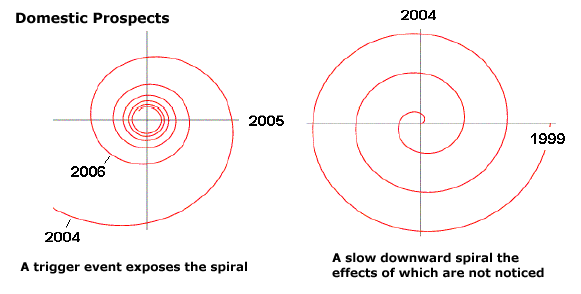Economic Spirals
Warren Pollock
written April 28, 2004
Posted Jun 1, 2004
Every aspect of life in the United States has become rich with
risk. I could outline some of the vulnerabilities but it's better
to illustrate the mentality which prevents systemic risk from
being discounted by the marketplace.
One of the largest risks in dislocation I see pertains to a concept
called "integration." What integration means is that
as a society our systems of food supply, markets, and energy
operate so efficiently through inter-reliance and dependency
that these systems have absolutely no capacity redundancy, or
resiliency to absorb a severe shock.
In the right hand spiral, future risks have not been priced into
the system. In fact, risks have been discounted to so low a threshold
that all investment provides negative rates of return.
(These spirals are illustrative
to time, the dates are illustrative).

Money cannot be profitably
allocated to reduce the risk. For example, an oil price of $55
per barrel would spur investment in alternative energy thereby
reducing systemic risk. It would do so at the expense of consumption
which people incorrectly perceive to be a measure of domestic
prospects and prosperity.
People "are happy" with the spiral on the right because
they don't notice that irrevocable change has occurred. The risk
reward equation has no choice but to normalize to the facts.
Without doubt a trigger event will occur and it will wake everybody
up with dramatic effect and implications.
International Integration means that only a tiny amount of infrastructure
needs to be disrupted to adversely effect the continuity of the
entire domestic economic system. The problem resides in the fact
that in such circumstance domestic prospects will degrade rapidly
potentially causing severe dislocations. The situation could
become so serious that government might have to assure that shortfall
resources are prioritized to social objectives including food
production and distribution.
It's essential to hedge against risks that has not been
discounted into the system. Physical gold may (or may not) provide
that functionality.
Recently Jim Sinclair rendered the best advice possible.
He stated that ten percent of liquid net worth should be allocated
to gold bullion coins because it provides insurance against uncertainty
and systemic risk. Personally I am at 5% allocation of net worth
to physical gold, with a 10% target. I have also taken my own
advice by allocating assets to archive geographical and
international diversity. Investing in physical gold and international
diversification come at the cost of yield. However, I feel that
doing nothing, chasing yield, or assuming that quality of life
within the United States can go on as usual will prove to be
a fatal mistake.
A trigger event over time will be assured.
Warren Pollock
The Macroeconomic Newsletter
April 28, 2004
eMail pollock.warren@verizon.net
This generalized
publication seeks to discuss macroeconomics, technical analysis,
investing theory, politics, news and markets. This newsletter
does not provide specific advice to any individual. It's our
recommendation and opinion that individuals should seek the counsel
of a licensed financial adviser who can design a plan appropriate
to specific financial conditions, objectives, and risk tolerance.
The publishers of this letter may purchase, hold, and dispose
of positions in financial instruments discussed herein at will.
The newsletter is published to its subscribers on a regular basis.
________________
321gold Inc

|

